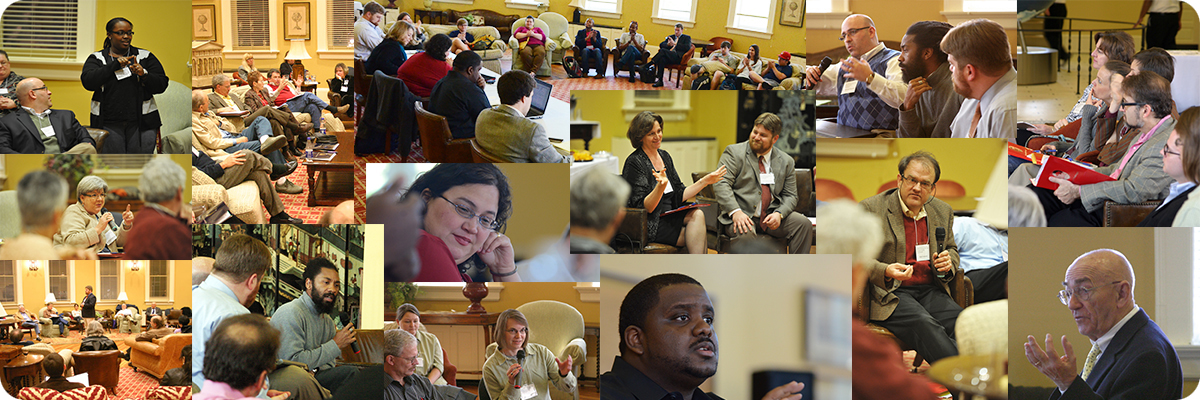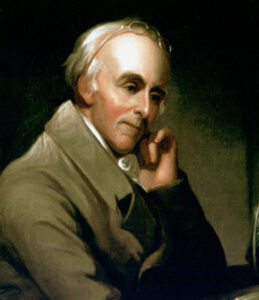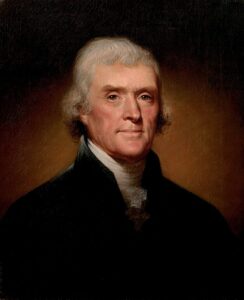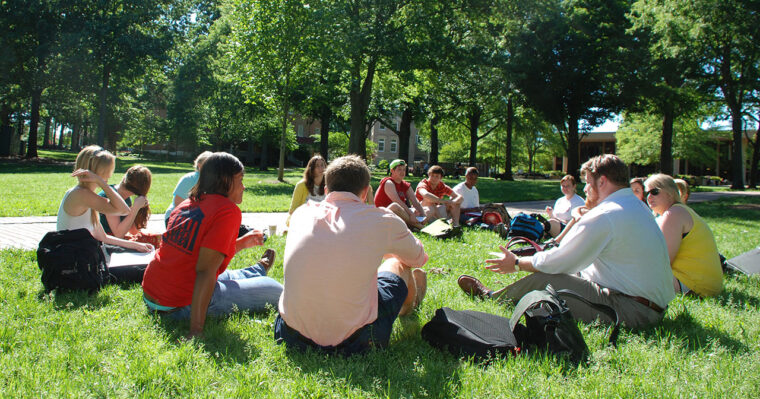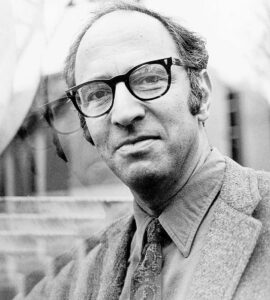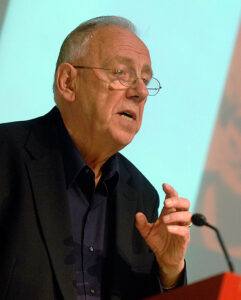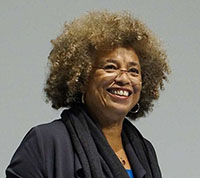| By Preston Stovall |
Part 1: Speaking to the Middle
I
An educated populace is crucial for a well-functioning democracy, and in the U.S. the use of pamphlets, periodicals, opinion pieces, and public letters, stretching back before the revolution, testifies to the importance that Americans place on an educated public. The use of these devices has helped keep American citizens apprised of the problems we face, and in the early Republic especially it was an important method of consensus-building.
This interest found kindred expression in a general concern with education in the United States and the colonies, one that many of the founders shared: Benjamin Franklin was instrumental in the creation of what would become the University of Pennsylvania, Benjamin Rush founded both Dickinson college and what would become Franklin and Marshall College (‘Franklin’ named after Benjamin), and Thomas Jefferson worked to establish a system of schools in Virginia, from the local level up to the University of Virginia, with the aim of selecting the brightest pupils for further instruction at each stage.
These projects were animated by a sense of education as something like a public resource for the American people. As a public resource education offers individual citizens not only a path to gainful employment but also the possibility of improving our lives by developing the habits of thought and conscience that accrue through a period of prolonged engagement with the thoughts and deeds of those who came before us. And by creating such citizens American education offers, for the public, successive cohorts able to sustain the intelligent collective reflection over the shape of American society that attends our participation in this experiment in self-government.
Thinking of education as a resource for the American people highlights the importance of the principles and institutions that shape its management. For just as the principles governing (e.g.) Fish, Wildlife, and Park services for U.S. citizens are enforced by various institutional mechanisms, and these geared toward the end (in part) of allowing us to enjoy the public goods that come with resource use in wilderness areas, so are the institutions of education meant to be run by principles that enable American citizens to enjoy the personal and social benefits that come with education. And just as access to wilderness areas redounds on the health of American society and its citizens, so does access to education. This analogy suggests that if education is a resource for the American people then educators—as stewards of the use of that resource—have a duty to mind the institutional norms and mechanisms that enable the public to enjoy its benefits, just as employees of FWP have a duty to mind resource management in wilderness areas.
Despite its close ties to the founding of the Republic, in practice higher education, as with political representation, would remain for generations the province of the elite, however. When Jefferson speaks of the “best geniuses” that will be “raked from the rubbish annually” by the school system he proposed for Virginia (Ford 2010, 61), his candidate geniuses were white men from families wealthy enough to pay for higher education.
It is a testament to the animating ideals of the American system of government that we have gradually overcome some of the barriers obstructing the universal enjoyment of our rights to life, liberty, and the pursuit of happiness. If the development of American society is to proceed on the basis of a more thorough realization of the principles of individual liberty and collective self-government that animate our country, and if education in the United States offers both the individual benefit of personal betterment and the public good of intelligent control over the shape of our union, then it will be important that American educational institutions foster the mutual understanding that precedes collective action. For we cannot effectively work together on a common project if we do not understand what our partners want and are trying to accomplish.
II
Unfortunately, we live in a time of increasing political polarization in the United States, and this makes it harder for people to understand one another across political divides (see section III for the details). This polarization has grown sharply in the last twenty-five years. According to the Pew Research Center, in 2016 more than 50% of those identifying either as Democrat or Republican held not only an unfavorable but a very unfavorable view of the other party (Pew Research Center 2016b). By contrast, in 2014 43% of Republicans and 38% of Democrats had a very unfavorable view of the other party, and in 1994 these percentages were just 17% and 16%, respectively (Pew Research Center 2014). This growing divide is reflected in different views about what our top priorities should be (Jones 2019). There is also a rising sense that public discourse on political issues has become too divisive (Pew Research Center 2019).
This situation makes it difficult for people of different political views to talk to one another without the conversation devolving into acrimony. That in turn makes it difficult to share and improve on the ideas we have about what we are facing and what to do about it. It would thus seem that U.S. educators, qua stewards of the public resource that is education, bear a duty to intervene in this situation in ways that foster the collective understanding and self-government that I am suggesting education offers the American people.
III
There are reasons to be optimistic about the possibility of such intervention. Research going back over three decades suggests that Americans share more political commitments than they realize, and that it is the vocal minorities in the wings that are driving the sense of a division. Summarizing a recent study and the associated background literature, Stevens (2019) writes (emphasis in the original):
- Democrats and Republicans significantly overestimate how many people on the ‘other side’ hold extreme views. Typically, their estimates are roughly double the actual numbers for a given issue.
- Greater partisanship is associated with holding more exaggerated views of one’s political opponents.
- The Perception Gap is strongest on both “Wings” (America’s more politically partisan groups).
- Consumption of most forms of media, including talk radio, newspapers, social media, and local news, is associated with a wider Perception Gap.
- Education seems to increase, rather than mitigate, the Perception Gap (just as increased education has found to track with increased ideological prejudice). College education results in an especially distorted view of Republicans among liberals in particular.
- The wider people’s Perception Gap, the more likely they are to attribute negative personal qualities (like ‘hateful’ or ‘brainwashed’) to their political opponents.
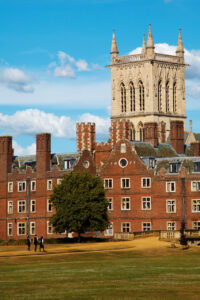
My proposal in this essay is that educators make an effort to speak to the middle on politically-charged issues, and toward that end I gather together some social-scientific data and offer an interpretive gloss about how to proceed. My focus will lie on the situation on college campuses, as I believe that university educators have a particular duty to model the norms of thoughtful conversation that are needed for the development of mutual understanding. Higher education in the U.S. today has seen its own trends of increased political polarization, however, and so it will be important for the academician to address the problem as it appears within the academy as well. But if we educators can build up a bulwark of sensible people in the middle of the debate on university campuses, we might hope to more effectively intervene in the situation with the public at large.
Part 2: Speaking to the Middle on University Campuses
IV
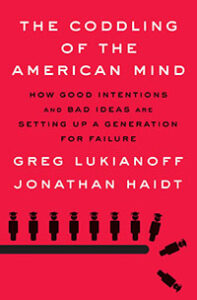
A number of high-profile incidents in 2017 exacerbated the sense of a crisis (Bauer-Wolf 2017, F.I.R.E. 2018, Friedersdorf 2017, Helsel 2017, The Olympian Editorial Board 2018) and though there is reason to think the wave crested that year (Burnett 2019 and Sachs 2019a), the problem remains with us (Anderson 2020, Bauer-Wolf 2019, Campbell 2018, Mangan 2019, McLaughlin 2017, Stripling 2020, and Zoeller and Majeed 2019).
A number of themes recur over these discussions. Lukianoff and Haidt speak of the ‘coddling’ of the American mind, and Campbell and Manning (2018) warn of a rise of ‘victimhood culture’ on college campuses that is supplanting cultures of ‘honor’ and ‘dignity’ (they curate a blog – victimhoodculture.com – devoted to the phenomenon). Steven B. Gerrard argues that the American university system has moved through three eras, from the Christian college to the gentleman’s college to the consumer college, and is at the dawn of a fourth: the comfort college (2019a and 2019b). From Gerrard (2019a):
[C]ontroversies over free speech, safe spaces, trigger warnings, microaggressions and the like are symptoms of this shift. They are currently considered controversies because the colleges are in transition, and many do not realize that the old standards no longer hold. Once the transition is complete, the “correct” side of the controversies will become central to a school’s identity — just as faith was to the Christian college, self-confidence was to the gentlemen’s college, and alumni devotion and achievement were to the consumer’s college.
Comparisons to religious fanaticism and Orwellian groupthink are also common. Robert Boyers (2016) speaks of the missionary attitude student activists sometimes display, and quoting Yale English professor David Bromwich he speaks of “a church held together by the hunt for heresies.” Trent Eady, a former student activist at McGill University in Canada, identifies four “core features” of today’s social justice activism that contribute to its “dark and vaguely cultish” brand of politics: dogmatism, groupthink, a crusader mentality, and anti-intellectualism (Eady 2014). Insofar as college campuses are breeding grounds for these kinds of attitudes, this situation reinforces the impression that higher education is currently compounding the divisiveness we see in the public sphere.
V
While the political right is responsible for its own attacks on the academy (cf. Alterman 2016, Beauchamp 2018, Dutt-Ballerstadt 2018), it is frequently pointed out that this state of affairs follows a period where the political orientations of university educators in the United States moved sharply to the left while the rest of the public did not. From Abrams (2016a; see also Abrams 2016b):
While the data confirms that university and college faculty have long leaned left, a notable shift began in the middle of the 1990s as the Greatest Generation was leaving the stage and the last Baby Boomers were taking up teaching positions. Between 1995 and 2010, members of the academy went from leaning left to being almost entirely on the left. Moderates declined by nearly a quarter and conservatives decreased by nearly a third.
…
[During this period] the professoriate was changing while the electorate as a whole was not. Professors were more liberal than the country in 1990, but only by about 11 percentage points. By 2013, the gap had tripled; it is now more than 30 points. It seems reasonable to conclude that it is academics who shifted, as there is no equivalent movement among the masses whatsoever.
Some disciplines (e.g. economics) tend to slant to the right, but the social sciences and humanities display particularly left-leaning faculties (Bennett 2015, Duarte et al. 2015, Langbert et al. 2016, and Wilson 2019), as do elite liberal arts colleges (Langbert 2018 and Al-Gharbi 2019a).
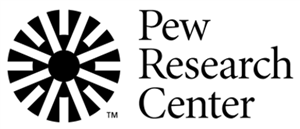
Many explanations might be offered here, including that liberals self-select for college instruction at a higher rate than conservatives, that liberal values are naturally more appealing as one goes through higher education, or that more general institutional and administrative mechanisms within the university are the source of this correlation rather than university instruction itself. But in 2015 72% of the adult public did not have a college degree, and 48% of this group display a mix of values that is not neatly captured by lumping them into either the liberal or the conservative camp. And considering the whole of the American adult population, 36% and 27% fall on either the liberal or the conservative ends respectively, while 38% display a mix of both sorts of values.
Now recall the data from part III showing a correlation between more extreme partisan political commitment and more distorted views of the ‘other side,’ and showing that this perception gap was increased by college education and consumption of most forms of media. If in the absence of college education the general public tends to divide evenly over conservative and liberal mindsets, with nearly half of that group not clearly identifying with either, while almost 40% of the whole adult population (college educated or not) doesn’t neatly identify with either, then an educated liberal elite wielding disproportionate influence in news media, the arts, and public discussion can only accelerate this polarization cycle, and the distortions in understanding brought with it. Add a mix of new media platforms and the ideological echo chambers they allow for, and the situation we face today is not all that surprising.
To be clear, I am not claiming that there is anything in particular about leftist thought that is the source of the problem, and here it is worth quoting Al-Gharbi (2020):
The left is not the problem. Homogeneity is a problem. Parochialism is a problem. Dogmatism is a problem. And these are general problems, not left problems. In a world where most students, faculty and administrators skewed conservative to the same degree they currently skew liberal, we should expect to see roughly the same issues arise with respect to bias, discrimination, censorship, institutional capture, etc. (indeed, we do observe just that in situations where the tables are turned).
VI
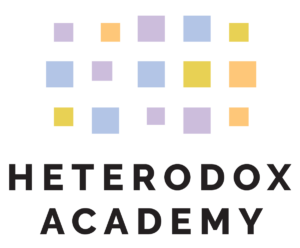
As with the so-called ‘free speech crisis’ on college campuses, not everyone agrees that the shift in distribution of political ideology across the academy that we have witnessed in the last three decades is a problem, or that it is having a corrupting influence on the attitudes of college students (see the essays in Katzav and Vaesen 2017, and Sachs 2019b). This is not the essay to address that debate, for the point here is that a number of intelligent men and women have concluded that there is such a problem, and the existence of considered disagreement on the issue militates against treating it as settled one way or the other. And that in turn bears consequences for how the educator ought to behave.
In another essay (forthcoming) I use Kuhn’s account of scientific revolutions to frame a view of Normal and Revolutionary periods concerning what Hegel called Sittlichkeit (ethical life), the body of norms that bind a people together as a society (roughly). In cases of Revolutionary ethical living, I argue, the educator is obliged to resist the urge to treat his or her favored view as Normal. Instead, what I call revolutionary pedagogy is one that fosters sustained and critical engagement with a variety of ethical points of view. A similar duty falls on the public work we do as academics living in a Revolutionary ethical period. For in times of ideological conflict within a society we must give special attention to, by way of engagement with, the perspectives of those with whom we disagree—only then can we hope to come to that mutual understanding which grounds effective collective action. As university educators with public-facing personas, academicians have a role to play in modeling that kind of charitable stance toward views we disagree with. One way of doing that is to try to speak to the middle, on the assumption that most people really are reasonable enough to understand one another.
On that front it is perhaps worth pointing out that in a recent study of undergraduate attitudes at the University of North Carolina at Chapel Hill, researchers found that while on the one hand conservative students were more reticent to share their views than liberals, there was a ‘hidden consensus’ among both liberals and conservatives in favor of free expression and open debate (Ryan 2020):
[I]t seems wrong to think of free expression on college campuses as a topic that must pit liberals against conservatives. At UNC, at least, many liberals and conservatives seem to want an environment where they can learn about and engage with views with which they disagree. I, for one, hope that students, faculty, and administrators alike renew our efforts to make sure that this hidden consensus does not get lost amidst the noise.
Part 3: Looking Ahead
VII
Times of instability are often times of opportunity, opening up possibilities that were not live options in the normal go of things. Just so, the existence of widespread political disagreement presents an opportunity for reshaping some of our framework political commitments, and the division between the broadly ‘left’ and ‘right’ sides of the political spectrum in the U.S. may be approaching some kind of shift.
At the end of the 20th century a handful of thinkers articulated a response to the liberalism that had dominated so much of that century. Often discussed under the banner ‘communitarianism’, the philosophical ground for this point of view was spelled out by philosophers like Alasdair MacIntyre (2007 – first edition 1981) Michael Sandel (1998 – first edition 1982), and Charles Taylor (1989), and in the 1990s it was developed into a political position labelled ‘responsive communitarianism’ (see section 3 of Bell 2016). Communitarianism is experiencing something of a revival, joined by a number of views variously called ‘post-liberal’, ‘civic republican’, or ‘hard centrist’ (Brooks 2019, Cost 2018, Franklin 2019, Goodhart 2017, Fukuyama 2018, Papazoglou 2019, Polimédio 2019, Steiner 2019). These positions share an interest in balancing a liberal emphasis on individual autonomy with a recognition of the debts to community that provide the affective ground for the exercise of individual autonomy (as I read him, Kaufman in 2006, 2016, and 2017 examines a similar phenomenon occurring in philosophy during the modern period).
This emphasis on community relations and civic duty offers a complementary lens to lay alongside the one of individual freedom and civil rights that dominated our view of things in the last century, so as to see the autonomous person in proper depth against the background of her community. And in the last few years a number of organizations directed at fostering community dialogue and understanding have appeared in the United States (e.g. Weave at the Aspen Institute, Better Angels, BridgeUSA, Free Intelligent Conversation, Letter, and Thread). One might hope these institutions could be leveraged to help give voice to the middle ground of American political sentiment.
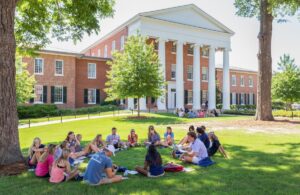
These and related positions might be used to frame more constructive exchanges among the partisans of different factions. Imagine a series of conferences and workshops modelled on Jefferson’s system of higher education: individual campuses would convene over the issues that concern them specifically, with regional, statewide, and national meetings to follow. Similar programs could be run concurrently within individual disciplines, and public outreach and education might follow. This would require concerted effort on the part of academics and their institutions, but it would seem within the realm of possibility.
VIII
Since before the Revolution the public space of debate and conversation has been a testing ground for the ideas around which consensus has coalesced. The existence of an educated public depends upon the existence of people willing to help with that education, however, and so by striving to create and use public spaces for constructive conversation we help the public see the problems we face and the possible solutions on offer. That in turn requires being careful in reconstructing the views of those we disagree with, particularly when talking to our own tribe about those we consider the Others.
There are encouraging signs on this front as well. Organizations like the Aspen Institute, the Foundation for Individual Rights in Education, the Heterodox Academy, the Institute of Art and Ideas, and the Society of Philosophers in America – as well as new media platforms like Aeon, Medium, Quillette, Salon, Slate, and UnHerd – are playing a role in disseminating ideas and conversations that allow those of us paying attention to get a better view of what’s going on.
There is a long tradition in the U.S. of public engagement by the members of the academy, especially on the part of philosophers. Contributions to public discourse from people like Richard Bernstein, Angela Davis, John Dewey, Jackie Kegley, John McDermott, Martha Nussbaum, Richard Rorty, and Cornell West embody the value we invest in a self-aware public. And as philosophers in the pragmatist tradition have long emphasized, the living organism is a thing that is constantly adapting and equilibrating itself to the ordered flux of experience. Only in so doing does it maintain its own vitality, and to do that intelligently the organism must be unified in its affective and responsive behaviors to the difficulties and opportunities it faces.
One role for the educator, I am suggesting, is to see that the body politic is similarly unified by equipping students with the intelligence and sensibilities needed to participate in this process. To do so is to help fulfill our function as stewards of the public resource that is education in the United States.
Author Note
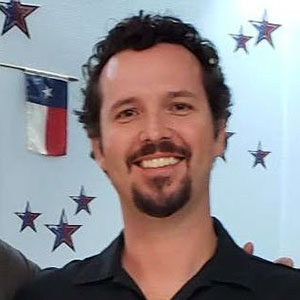
References
Abrams Sam. (2016a). “Professors Moved Left Since 1990s, Rest of Country Did Not”, Heterodox Academy, https://heterodoxacademy.org/professors-moved-left-but-country-did-not/, 9 January 2016. Accessed 15 July 2019.
Abrams, Sam. (2016b). “The Blue Shift of the New England Professoriate”, Heterodox Academy, https://heterodoxacademy.org/the-blue-shift-of-the-new-england-professoriate/, 6 July 2016. Accessed 23 July 2019.
Adler, Jonathan H. (2016). “The Death of Free Speech at Williams College”, The Washington Post, https://www.washingtonpost.com/news/volokh-conspiracy/wp/2016/02/22/the-death-of-free-speech-at-williams-college/?utm_term=.3785cecc2ff2, 22 February 2016. Accessed 23 July 2019.
Al-Gharbi, Musa. (2019a). “Campus and Community II: A Longitudinal Extension”, Heterodox Academy, https://heterodoxacademy.org/campus-community-diversity-longitudinal-extension/, 4 February 2019. Accessed 15 July 2019.
Al-Gharbi, Musa. (2019b). “How Universities Have Been Part of the Problem (And Can Be Part of the Solution) for America’s Civic Crises”, Heterodox Academy, https://heterodoxacademy.org/teaching-universities-can-help-ameliorate-american-civic-crises/, 6 September 2019. Accessed 19 March, 2020.
Al-gharbi, Musa (2020). “Potholes on the Road to Institutional Reform”, Heterodox Academy, https://heterodoxacademy.org/potholes-viewpoint-diversity-reform/, 25 February, 2020. Accessed 19 March, 2020.
Alterman, Eric. (2016). “Who’s Behind the Right-Wing Assault on Public Universities”, thenation.com, https://www.thenation.com/article/whos-behind-the-right-wing-assault-on-public-universities/, 1 September 2016. Accessed 12 September 2019.
Anderson, Greta. (2020). “Free Speech Challenges in Real Time”, Inside Higher Education, https://www.insidehighered.com/news/2020/02/28/students-protest-free-speech-conference, February 28 2020. Accessed March 24 2020.
Appiah, K. Anthony. (1994/1995). “Ancestral Voices”, Salmagundi, 104/105: 88-100.
Bauer-Wolf, Jeremy. (2017). “ACLU Speaker Shouted Down at William & Mary”, Insider Higher Education, https://www.insidehighered.com/quicktakes/2017/10/05/aclu-speaker-shouted-down-william-mary, 5 October 2017. Accessed 23 July 2019.
Bauer-Wolf, Jeremy. (2019). “Free Speech Laws Mushroom in Wake of Campus Protests”, Insider Higher Education, https://www.insidehighered.com/news/2019/09/16/states-passing-laws-protect-college-students-free-speech, 16 September 2019. Accessed 24 March 2020.
Bell, Daniel. (2016). “Communitarianism”, The Stanford Encyclopedia of Philosophy (Summer 2016 Edition), ed. Endward N. Zalta, https://plato.stanford.edu/cgi-bin/encyclopedia/archinfo.cgi?entry=communitarianism. Accessed 23 July 2019.
Bennett, Bo. (2015). “Why are There so Few Non-Liberals in Social Psychology? A Closer Look”, Heterodox Academy, https://heterodoxacademy.org/why-are-there-so-few-non-liberals-in-social-psychology-a-closer-look/, 7 November 2015. Accessed 15 July 2019.
Bloomberg, Michael and Charles Koch. (2016). “Why Free Speech Matters on Campus”, The Wall Street Journal, https://www.wsj.com/articles/why-free-speech-matters-on-campus-1463093280, 12 May 2016. Accessed 23 July 2019.
Boyers, Robert. (2016). “How ‘Safe Spaces’ Stifle Ideas”, The Chronicle of Higher Education, https://www.chronicle.com/article/How-Safe-Spaces-Stifle-Ideas/235634, 13 March 2016. Accessed 23 July 2019.
Brooks, David. (2019). The Second Mountain: The Quest for a Moral Life. New York: Random House.
Campbell, Bradley. (2018). “The Free Speech Crisis on Campus is Worse than People Think”, Quillette, https://quillette.com/2018/11/14/the-free-speech-crisis-on-campus-is-worse-than-people-think/, 14 November 2019. Accessed 23 July 2019.
Beauchamp, Zack. (2018). “Data Shows a Surprising Campus Free-Speech Problem: Left-Wingers Being Fired for Their Opinions”, Vox.com, https://www.vox.com/policy-and-politics/2018/8/3/17644180/political-correctness-free-speech-liberal-data-georgetown, 3 August 2018. Accessed 12 September 2019.
Burnett, Daniel. (2019). “50 Universities Now Earn FIRE’s Highest Rating for Free Speech”, The Foundation for Individual Rights in Education, https://www.thefire.org/50-universities-now-earn-fires-highest-rating-for-free-speech/, 16 July 2019. Accessed 23 July 2019.
Campbell, Bradley and Jason Manning. (2018). The Rise of Victimhood Culture: Microaggressions, Safe Spaces, and the New Culture Wars. New York: Palgrave Macmillan.
Cole, Jonathan. R. (2016). “The Chilling Effect of Fear at America’s Colleges”, The Atlantic, https://www.theatlantic.com/education/archive/2016/06/the-chilling-effect-of-fear/486338/, 9 June 2019. Accessed 23 July 2019.
Cost, Jay. (2018). “The Return of Civic Repbulicanism”, National Affairs, https://www.nationalaffairs.com/publications/detail/the-return-of-civic-republicanism, Summer 2018. Accessed 23 July 2019.
deBoer, Frederik. (2016). “Watch What you Say: How Fear is Stifling Academic Freedom”, The Chronicle of Higher Education, https://www.chronicle.com/article/Watch-What-You-Say/234983, 22 January 2016. Accessed 23 July 2019.
Duarte, José L., Jarret T. Crawford, Charlotta Stern, and Jonathan Haidt. (2015). “Political Diversity Will Improve Social Psychological Science”, Behavioral and Brain Sciences, 38 (e130), available at https://doi.org/10.1017/S0140525X14000430. Accessed 15 July 2019.
Dutt-Ballerstadt, Reshmi. (2018). “Striking a Nerve”, insidehighered.com, https://www.insidehighered.com/advice/2018/03/02/what-do-when-you-are-academic-under-attack-right-wing-publications-opinion, 2 March 2018. Accessed 12 September 2019.
Eady, Trent. (2014). “Everything is Problematic”, The McGill Daily, https://www.mcgilldaily.com/2014/11/everything-problematic/, 24 November 2014. Accessed 23 July 2019.
F.I.R.E. (2018). “The 10 Worst Colleges for Free Speech: 2018”, The Foundation for Individual Rights in Education, https://www.thefire.org/the-10-worst-colleges-for-free-speech-2018/, 12 February 2018. Accessed 23 July 2019.
Ford, Paul. L. (2010). The Works of Thomas Jefferson, Vol. IV (in 12 Volumes): Notes on Virginia II, Correspondence 1782-1786. New York: Cosimo Classics.
Franklin Peter. (2019). “Call Yourself Post-Liberal?”, UnHerd, https://unherd.com/2019/04/how-post-liberal-are-you/, 3 April 2019. Accessed 18 July 2019.
Friedersdorf, Conor. (2016). “The Glaring Evidence that Free Speech is Threatened on Campus”, The Atlantic, https://www.theatlantic.com/politics/archive/2016/03/the-glaring-evidence-that-free-speech-is-threatened-on-campus/471825/, 4 March 2016. Accessed 23 July 2019.
Friedersdorf, Conor. (2017). “Middlebury Reckons with a Protest Gone Wrong”, The Atlantic, https://www.theatlantic.com/politics/archive/2017/03/middleburys-liberals-respond-to-an-protest-gone-wrong/518652/, 6 March 2017. Accessed 23 July 2019.
Fukuyama, Francis. (2018). Identity: Contemporary Identity Politics and the Struggle for Recognition. London: Profile Books.
Gerard, Steven B. (2019a). “The Rise of the Comfort College”, Bloomberg.com, https://www.bloomberg.com/opinion/articles/2019-09-09/free-speech-is-no-longer-safe-speech-at-today-s-elite-colleges, 9 September 2019. Accessed 12 September 2019.
Gerard, Steven B. (2019b). “How Comfort Conquered College”, Bloomberg.com, https://www.bloomberg.com/opinion/articles/2019-09-10/how-comfort-college-dogma-conquered-reason-and-evidence, 10 September 2019. Accessed 12 September 2019.
Goodhart, David. (2017). The Road to Somewhere: The Populist Revolt and the Future of Politics. New York: Oxford University Press.
Haidt, Jonathan. (2012). The Righteous Mind: Why Good People are Divided by Politics and Religion. New York: Vintage Books.
Heller, Nathan. (2016). “The Big Uneasy: What’s Roiling the Liberal-Arts Campus?”, The New Yorker, May 30 2016.
Helsel, Phil. (2017). “Protests, Violence Prompt UC Berkeley to Cancel Milo Yiannopoulos Event, NBC News, https://www.nbcnews.com/news/us-news/protests-violence-prompts-uc-berkeley-cancel-milo-yiannopoulos-event-n715711, 2 February 2017. Accessed 23 July 2019.
Jaschik, Scott. (2017). “Shouting Down a Lecture”, insidehighered.com, https://www.insidehighered.com/news/2017/03/03/middlebury-students-shout-down-lecture-charles-murray, 3 March 2017. Accessed 13 September 2019.
Jaschik, Scott. (2017). “Another Speaker Unable to Appear at Middlebury”, insidehighered.com, https://www.insidehighered.com/news/2019/04/18/middlebury-calls-lecture-conservative-polish-leader-amid-threats-protests, 18 April 2019. Accessed 13 September 2019.
Jones, Bradley. (2019). “Republicans and Democrats Have Grown Further Apart on What the Nation’s Top Priorities Should Be”, Pew Research Center, https://www.pewresearch.org/fact-tank/2019/02/05/republicans-and-democrats-have-grown-further-apart-on-what-the-nations-top-priorities-should-be/, 5 February 2019. Accessed 15 July 2019.
Katzav J. and Vaesen K. (2017). “On the Emergence of Analytic Philosophy”, British Journal for the History of Philosophy, 25, (4): 772-798.
Kaufman, Daniel A. (2006). “Knowledge, Wisdom, and the Philosopher”, Philosophy 81: 129-151.
Kaufman, Daniel A. (2016). “Reason and the Post-Human”, The Electric Agora, https://theelectricagora.com/2016/02/28/excessive-reason/, 28 February 2016. Accessed 27 March 2020.
Kaufman, Daniel A. (2016). “Excessive Reason”, The Electric Agora, https://theelectricagora.com/2017/06/21/reason-and-the-post-human/, 21 June 2017. Accessed 27 March 2020.
Langbert, Mitchell. (2018). “Homogeneous: The Political Affiliations of Elite Liberal Arts College Faculty”, Academic Questions, 31, (2): 186-197.
Langbert, Mitchell, Anthony J. Quain, and Daniel B. Klein. (2016). “Faculty Voter Registration in Economics, History, Journalism, Law, and Psychology”, Econ Journal Watch, 13, (3): 422-451.
Lukianoff, Greg. and Jonathan Haidt. (2015). “The Coddling of the American Mind”, The Atlantic, https://www.theatlantic.com/magazine/archive/2015/09/the-coddling-of-the-american-mind/399356/, September 2015. Accessed 23 July 2019.
Lukianoff, Greg and Jonathan Haidt. (2018). The Coddling of the American Mind: How Good Intentions and Bad Ideas are Setting up a Generation for Failure. London: Penguin Books.
MacIntyre, Alasdair. (2007). After Virtue: A Study in Moral Theory, Third Edition. Notre Dame: University of Notre Dame Press.
Mangan, Katherine. (2019). “If There Is a Free-Speech ‘Crisis’ on Campus, PEN America Says, Lawmakers Are Making It Worse”, The Chronicle of Higher Education, https://www.chronicle.com/article/If-There-Is-a-Free-Speech/246031, 2 April 2019, Accessed 23 July 2019.
McLaughlin, Eliott C. (2017). “War on Campus: The Escalating Battle over College Free Speech”, Cnn, https://edition.cnn.com/2017/04/20/us/campus-free-speech-trnd/index.html, 1 May 2017. Accessed 23 July 2019.
McWhorter, John. (2015). “Antiracism, Our Flawed New Religion, The Daily Beast, https://www.thedailybeast.com/antiracism-our-flawed-new-religion, 27 July 2015. Accessed 23 July 2019.
Mulligan, Susan. (2015). “From Megaphones to Muzzles”, U.S. News and World Report, 25 November 2015.
The Olympian Editorial Board. (2018). “Evergreen Still Making Course Corrections”, The Olympian, https://www.theolympian.com/opinion/editorials/article212226769.html, 1 June 2018. Accessed 23 July 2019.
Papazoglou, Alexis. (2019). “The Philosophical Roots of Today’s Immigration Debate”, The New Republic, https://newrepublic.com/article/152883/philosophical-roots-todays-immigration-debate, 15 January 2019. Accessed 18 July 2019.
Polimédio, Cayenne. (2019). “Communitarianism 2.0”, New America, https://www.newamerica.org/weekly/edition-255/return-of-communitarianism/, 27 June 2019. Accessed 18 July 2019.
Pew Research Center. (2014). “Political Polarization in the American Public”, https://www.people-press.org/2014/06/12/political-polarization-in-the-american-public/, 12 June 2014. Accessed 15 July 2019.
Pew Research Center. (2016a). “A Wider Ideological Gap Between More and Less Educated Adults”, https://www.people-press.org/2016/04/26/a-wider-ideological-gap-between-more-and-less-educated-adults/, 26 April 2016. Accessed 15 July 2019.
Pew Research Center. (2016b). “Partisanship and Political Animosity in 2016”, https://www.people-press.org/2016/06/22/partisanship-and-political-animosity-in-2016/, 22 June 2016. Accessed 15 July 2019.
Pew Research Center. (2019). “Public Highly Critical of State of Political Discourse in the U.S.”, https://www.people-press.org/2019/06/19/public-highly-critical-of-state-of-political-discourse-in-the-u-s/, 19 June 2019. Accessed 15 July 2019.
Ripley, Amanda. (2018). “Complicating the Narratives”, The Whole Story, https://thewholestory.solutionsjournalism.org/complicating-the-narratives-b91ea06ddf63, 27 June 2019. Accessed 24 July 2019.
Rosenkranz, Nicholas Quinn. (2015). “Heterodox Academy”, The Washington Post, https://www.washingtonpost.com/news/volokh-conspiracy/wp/2015/09/15/heterodox-academy/?utm_term=.47e09a8311f4, 15 September 2015. Accessed 23 July 2019.
Ryan, Timothy. (2020). “The Hidden Consensus on Free Expression”, Heterodox Academy, https://heterodoxacademy.org/viewpoint-diversity-hidden-consensus-free-expression/, 20 February 2020. Accessed 30 March 2020.
Sachs, Jeffrey Adam. (2019a). “The “Campus Free Speech Crisis” Ended Last Year”, Niskanen Center, https://niskanencenter.org/blog/the-campus-free-speech-crisis-ended-last-year/, 25 January 2019. Accessed 23 July 2019.
Sachs, Jeffrey Adam. (2019b). “Community and Campus: The Relationship Between Viewpoint Diversity and Community Partisanship”, Heterodox Academy, https://heterodoxacademy.org/viewpoint-diversity-community-partisanship/, 25 January 2019. Accessed 15 July 2019.
Sandel, Michael J. (1998). Liberalism and the Limits of Justice, Second Edition. New York: Cambridge University Press
Shanahan, Marie K. (2016). “Yes, Campuses Should be Safe Spaces—for Debate”, The Chronicle of Higher Education, https://www.chronicle.com/article/Yes-Campuses-Should-Be-Safe/235114, 31 January 2016. Accessed 23 July 2019.
Shweder, Richard A., Nancy C. Much, Manamohan Mahapatra, Lawrence Park, “The “Big Three” of Morality (Autonomy, Community, Divinity) and the “Big Three” Explanations of Suffering”. In Morality and Health, edited by Allan Brandt and Paul Rozin. New York: Routledge, 119-116.
Steiner, M. T. (2019). “Post-Liberal Politics – Left, Right, and Center”, Quillette, https://quillette.com/2019/07/02/post-liberal-politics-left-right-and-center/, 2 July 2019. Accessed 18 July 2019.
Stevens, Sean. (2019). “The Perception Gap: How False Impressions are Pulling Americans Apart”, Heterodox Acadmy, https://heterodoxacademy.org/social-science-partisan-perception-gap/, 28 June 2019. Accessed 23 July 2019.
Stovall, Preston. (forthcoming). “Education is the Art of Making Humanity Ethical”. In Diversity in Perspective, edited by Cinzia Ferrini. Trieste: Italian University Press.
Stripling, Jack. (2020). “How Far Will Higher Ed’s Culture Wars Go? South Dakota is Running Previews”, The Chronicle of Higher Education, https://www.chronicle.com/article/How-Far-Will-Higher-Ed-s/248254, March 17, 2020. Accessed 24 March 2020.
Taylor, Charles. (1989). Sources of the Self: The Making of the Modern Identity. Cambridge: Harvard University Press.
Yglesias, Matthew. (2019). “The Great Awokening”, Vox.com, https://www.vox.com/2019/3/22/18259865/great-awokening-white-liberals-race-polling-trump-2020, April 1, 2019. Accessed September 12, 2019.
Wilson, J. Matthew. (2019). “The Nature and Consequences of Ideological Hegemony in American Political Science”, PS: Science and Politics, 1-4, https://doi.org/10.1017/S1049096519000659. Accessed 15 July 2019.
Zoeller, Mary and Azhar Majeed. (2019). “Williams College ‘Inquiry and Inclusion’ Report a Mixed Bag on Campus Free Speech, Will Bear Further Watching”, The Foundation for Individual Rights in Education, https://www.thefire.org/williams-college-inquiry-and-inclusion-report-a-mixed-bag-on-campus-free-speech-will-bear-further-watching/, 18 July 2019. Accessed 23 July 2019.
